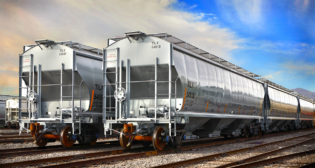
Freight car market will see moderate expansion: EPA
Written by William C. Vantuono, Editor-in-Chief“In 2015, weakness in both the coal markets and a lack of current demand for intermodal equipment will level deliveries to 60,500 cars,” EPA said. “Beginning in 2016, annual railcar assemblies will expand very moderately from 60,300 units to 62,500 cars and platforms in 2019.”
For the longer term, EPA said that stronger economic activities should provide support for certain railcar assemblies, while an improvement in the financial environment, high gasoline prices, and strong government backing stimulate greater demand for ethanol and DDG cars. Replacement pressures and technological advances as well as legislative measures will also play a role in promoting the demand for a variety of railcars.
Construction activities are expected to continue to advance, “which should support movements of aggregates and structural steel products,” EPA said. “Continued expansion in demand for crude oil, petroleum products, chemicals, and food and beverages will prop up haulings of a variety of liquid products and the demand for tank cars. Growing worldwide nutritional needs and expanding exports will pressure the current grain service cars as we proceed through the longer term, while long neglected segments such as equipment to haul waste, aggregates, and limestone show signs of revival and should add to the railcar delivery mix in the years to come. However, the most dynamic element in the long-term railcar environment will be tank cars to transport ever-increasing volumes of oil and petroleum products.”
“Total railcar orders rebounded in the fourth quarter primarily due to a surge in hi-cube covered hopper demand” EPA noted. “A significant number of petrochemical plants in the Gulf, other parts of Texas, and the East Coast (New Jersey) are starting up. Furthermore, we have been informed that more equipment will be needed as we proceed through 2014 and into 2015.
“Most other car types recorded various degrees of increases in fourth quarter orders, with the notable exceptions of coal cars, which continue to be dampened by Environmental Protection Agency regulations and a slowing in export markets, and intermodal equipment.
“Aside from coal cars, we are impressed by the broadening of demand for rolling stock. Tank car orders, which comprised 80.6% of total orders in the first quarter, 46.8% of orders in the second quarter, and 40.4% in the third quarter, only accounted for 33.1% of the orders in last year’s closing quarter. While it is true that a very substantial amount of hi-cube equipment could have shifted the balance, as noted above, fourth-quarter orders were received for a vast array of car types. We still believe that oil service tank cars will lead the parade in future orders. To be sure, recent [crude by rail] rail mishaps . . . are turning attention to tighten legislation to protect the population from severe future mishaps.
“Currently, there is a drive for tougher standards for oil rail shipments, including better testing of potentially explosive ultra light shale crude and the development of improved rail tank car standards. Tank cars produced before 2011 have been cited dangerously prone to puncture. Whether these developments result in major retrofitting projects or future purchases of new equipment remains to be seen. However, the fact of the matter remains that we have little alternative but rail to transport the bulk of our oil. And, our oil needs will continue to expand at a healthy clip.
“With regard to other car types, we continue to be concerned about the underwhelming growth of the economy as manufacturers, oil and gas producers, and coal companies struggle with the increasing number of government regulations dampening our economic potential. Hopefully, our economy can eventually embark on a stronger path of growth, which will improve railroad traffic, revenue, and investments, leading to continued healthy growth in railcar demand.
We have recently noted an estimated 3.2% increase in our fourth-quarter GDP, a smaller advance than the third quarter. From this point on, we look for continued growth in demand for boxcars and grain cars, along with a pickup in demand for small-cube covered hoppers and mill gondolas, and continued rapid expansion in tank car demand.
Even with an anticipated rebound in coal hauling this year, we remain relatively negative on the outlook for coal cars, primarily because we have heard that customers prefer to rebuild rather than purchase new equipment in the currently dismal coal environment. We now expect assemblies of GT gondolas and hoppers to amount to 1,750 units this year and 2,750 cars (primarily replacements) in 2015. Longer term, assemblies of GT gondolas and hoppers will expand very modestly to 5,500 units in 2019.
In spite of declines in agricultural products and coal, the Class I’s reported good revenues and profits in 2013. The railroads also continue to mention investments in track, facilities, and equipment. The solid income base of the railroads should serve to support railcar demand in the years to come. Also, they are indicating strong capital spending plans for 2014 as they prepare for continued growth in oil, chemical, light vehicle, and intermodal movements. And, the investments will be well founded as we witness future growth in these categories.
We continue to remain leery on the future course of auto sales through the next two years. Until the economy is on more solid footing, employment advances at a more significant pace, and consumer income growth increases, we expect quarterly auto sales to remain relatively flat at high levels during 2014 and 2015. After a 7.5% advance in motor vehicle sales to 15.62 million units in 2013, we expect more modest growth to 15.80 million vehicles in 2014 and 16.38 million units in 2015. Led by strong production gains in the U.S., Canada, and Mexico, motor vehicle carloadings advanced 16.5% in 2012. However, motor vehicle movements moderated to a 5.1% gain last year. This year, we expect a marked slowing in motor vehicle retail sales and North American production to result in a 2.6% increase in motor vehicle haulings, followed by a 2.3%advance in 2015. From 2016 through 2019, motor vehicle carloadings are expected to advance approximately 2.0% per year. We look for only moderate quarterly advances in factory output through 2014 and into 2015.
“Consumer spending will be sluggish, the job markets are weak, confidence has dropped, and consumers are looking to improve their balance sheets, rather than purchase more products. The export markets have slowed considerably over the past year and we expect further weakening in 2014, before there is some bounce back in global economic activities in 2015. And, the steel markets are reflecting the slowing in industrial activities. According to the American Iron and Steel Institute, domestic steel shipments through November of 2013 were running 0.8% below the previous year while steel imports were 4.6% lower in the first eleven months.
“As anticipated, exports of corn, wheat, and soybeans picked up in the fourth quarter of last year. More important, the USDA anticipates further gains in our crop exports this year, which should boost grain movements. Based on increased production, consumption, and exports, we expect a rebound in grain haulings this year and next. After an 8.0% drop last year, we expect grain haulings to increase 3.1% this year and 2.1% in 2015.”



